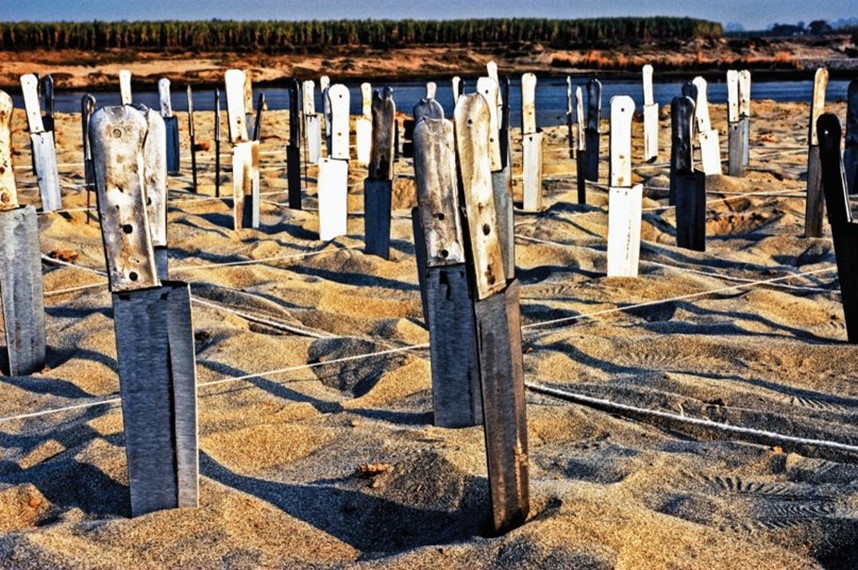Smithsonian’s National Museum of Asian Art Presents “Unstill Waters: Contemporary Photography from India”

“Riverbank I,” Ravi Agarwal (b. 1958), India, 2007, Inkjet print, H x W (unframed): 106.7 × 159.7 cm (42 × 62 7/8 in), Gift of Drs. Umesh and Sunanda Gaur, Arthur M. Sackler Gallery, S2019.6.4
The Smithsonian’s National Museum of Asian Art will present “Unstill Waters: Contemporary Photography from India,” an exhibition that features 29 works by some of the most prominent artists working in India. Through photography and video, these artists forefront the landscape of India, both real and imagined, as a powerful means to examine contemporary environmental and social issues of broader global concern. The exhibition will be on view in the Arthur M. Sackler Gallery Dec. 10–June 11, 2023—during the museum’s centennial—and celebrates Umesh and Sunanda Gaur’s gift to the museum’s growing collection of contemporary Asian photography.
Visually dynamic in scale and format, the works in “Unstill Waters” offer vivid perspectives on the human relationship to place. Artists Ketaki Sheth and Gigi Scaria look to the streets of Mumbai and New Delhi as their subjects, while the landscape view becomes a highly symbolic setting for Sheba Chhachhi. Atul Bhalla and Ravi Agarwal convey the profound importance of water, specifically the enduring cultural connection to the Yamuna River in northern India, its current endangered state and the relationship between rivers and rapidly changing urban life.
“Unstill Waters” complements the centennial exhibition “A Splendid Land: Paintings from Royal Udaipur” (Nov. 19–May 14, 2023). This major survey of 17th–19th-century works from Udaipur, India, centers on the city’s landscapes, lake systems and palaces and includes an ambient soundscape by the renowned experimental filmmaker Amit Dutta.
“As the National Museum of Asian Art enters its next century, we are even more committed to expanding our contemporary collection and placing it in dialogue with objects from Asia’s deep traditions of art,” said Chase F. Robinson, Dame Jillian Sackler Director of the Arthur M. Sackler Gallery and Freer Gallery of Art, the Smithsonian’s National Museum of Asian Art. “We are also celebrating the museum as a space where diverse people convene, converse and learn. ‘Unstill Waters’ incorporates all of this and exemplifies our mission to exhibit and interpret Asian art in ways that deepen our collective understanding of Asia, the U.S. and the world.”
An accompanying program series in conjunction with the opening of the exhibition (details below) explores cultural attitudes toward water and speaks to environmental racism, resource management and climate concerns both locally and globally, discussing the parallel histories of the Yamuna River and the Anacostia River in Washington, D.C. Speakers include an artist featured in “Unstill Waters,” professors of environmental and global studies and staff from the Smithsonian’s Anacostia Community Museum.
“Umesh and Sunanda Gaur have been collecting with the goal of supporting collaborations with scholars and students, and to help others learn about India through the extraordinary work of modern and contemporary artists,” said Carol Huh, associate curator of contemporary Asian art. “It is an honor and a pleasure to follow their generous example through this exhibition and related programs.”
Events
Yamuna/Anacostia: Rivers and Environmental Racism
Saturday, Dec. 10; 1–3 p.m. ET
Hybrid: Online and onsite in the Freer Gallery of Art
This program will draw on key themes from “A Splendid Land” and “Unstill Waters.” Artists and scholars will explore the parallel histories of the Yamuna and Anacostia rivers, contemporary community-led efforts to address the harm done to the rivers and the communities that rely on them, and the role of image-making as a tool for environmental justice.
Speakers:
- Ravi Agarwal, artist, environmental campaigner, writer and curator
- Katrina Lashley, program coordinator, Anacostia Community Museum
- Anne Rademacher, professor of environmental studies, New York University
- Bishnupriya Ghosh, professor of English and global studies, University of California, Santa Barbara
Artist Talk: Ravi Agarwal
Saturday, Dec. 10; 4 p.m.
Onsite: Arthur M. Sackler Gallery
Curator Carol Huh and artist Ravi Agarwal will discuss works in “Unstill Waters.”
Additional Modern and Contemporary Art Spaces Coming Summer 2023
Building on the groundbreaking legacy of contemporary exhibitions—the museum was the first in the United States to have a dedicated program in contemporary Asian art—the National Museum of Asian Art will launch new spaces devoted to modern and contemporary art beginning in summer 2023. New acquisitions are continually added to the collections to showcase the evolving visual cultures of Asia in the 20th and 21st centuries.
About the Smithsonian’s National Museum of Asian Art
The Smithsonian’s National Museum of Asian Art is committed to preserving, exhibiting, researching and interpreting art in ways that deepen our collective understanding of Asia and the world. Home to more than 45,000 objects, the museum stewards one of North America’s largest and most comprehensive collections of Asian art, with works dating from antiquity to the present from China, Japan, Korea, South Asia, Southeast Asia and the Islamic world. Its rich holdings bring the arts of Asia into direct dialogue with an important collection of 19th- and early 20th-century American works, providing an essential platform for creative collaboration and cultural exchange between the United States, Asia and the Middle East.
Beginning with a 1906 gift that paved the way for the museum’s opening in 1923, the National Museum of Asian Art is a leading resource for visitors, students and scholars in the United States and internationally. Its galleries, laboratories, archives and library are located on the National Mall in Washington, D.C., and are part of the world’s largest museum complex, which typically reports more than 27 million visits each year. The museum is free and open to the public 364 days a year (closed Dec. 25), making its exhibitions, programs, learning opportunities and digital initiatives accessible to global audiences.
# # #
SI-363-2022
